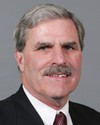Mr. Chair, I am pleased to have this opportunity to speak about the Government of Canada's border security initiatives and more specifically our integrated approach to border management. It is take note debates like this that are useful, where members can present to their constituents that they are very active on these matters and that the government is listening. With the exception of the member for Prince George—Peace River, there has been a lot of constructive comment that the government will be examining, I am sure.
The present government has adopted a strategic position with its U.S. partners, based on initiatives such as the smart border declaration and the more recent North American security and prosperity partnership, in order to continue to make considerable progress toward our common objectives of public safety and economic security.
Ensuring the security of the border is in our mutual best interests. Canada is currently engaged in efforts to enhance and further secure travel documents.
Members opposite talk about inaction. The comment that President Bush made on the steps of the White House did not go unnoticed here in Canada. The statements by Ms. Clinton and by the governor of New York, Mr. Pataki, have not gone unnoticed. There has been a tremendous amount of effort through our consuls general to the United States and also at the officials level to come up with a workable solution to this matter.
As the House knows, the United States introduced legislation referred to as the western hemisphere travel initiative, which is what we are discussing tonight. It will require that all individuals travelling to the U.S., all individuals including U.S. citizens, present a passport or another secure document effective in 2007. I can assure members that the Government of Canada has been consulting stakeholders in Canada and the United States and U.S. government officials at every level on this initiative.
Ultimately, our goal is to keep terrorists and other criminal elements out and allow legitimate trade and travellers to move smoothly across the border. However, we share some of the concerns, as I said, of Senator Hillary Clinton, New York State Governor George Pataki and others in the United States about how the western hemisphere travel initiative is moving ahead too quickly and without the proper consideration of other options.
This issue is much too important to rush through. The border operates in a real time environment, providing service at air, sea and land ports of entry 24 hours a day, seven days a week at some of its busiest locations. This enables us to deal more quickly and effectively with trade and security concerns here at home and abroad. In real terms, this meant that last year, the Canada Border Services Agency processed close to 95 million travellers. This means 71 million people and 37 million vehicles by highway, 20 million by air, and 12 million commercial releases. Many Canadian industries now participate in programs to streamline the border clearance process for pre-approved, low risk travellers and goods.
I would like to briefly outline some of the excellent programs that both enhance safety and security at the U.S.-Canada border and ensure that commerce and trade are not jeopardized. As members will see, there is a long tradition of working together with our counterparts and I am sure this will continue as we cooperate on ensuring the security of documents used by those crossing the Canada-U.S. border.
First of all, the free and secure trade program, or FAST, is a harmonized commercial process offered to pre-approved importers, carriers and registered drivers to facilitate clearance into either Canada or the United States with greater speed and certainty. Frequent cross-border travellers can also take advantage of NEXUS, a binational program that both simplifies border transit and reduces wait times.
CANPASS Air has been implemented at seven international airports using iris recognition technology to streamline our travel. CANPASS Air allows its members to expedite their own border clearance quickly and securely. When CANPASS Air was implemented at Vancouver International Airport in July 2003, this was the first time in North America that iris recognition technology was used to facilitate a traveller's border clearance. Now travellers flying into Halifax, Montreal, Toronto, Winnipeg, Edmonton and Calgary can also clear customs and immigration in the blink of an eye.
This partnership agreement is one more fine example of the close collaboration that exists between Canada and the U.S. to ensure the security and prosperity of our two countries.
These and other accomplishments reflect the multiple border strategy and the effort to interdict high risk travellers and cargo before they arrive in Canada. To that end, we work closely with our partners and deploy mitigation integrity officers overseas. These officers work with airlines and local authorities, share intelligence, detect document fraud and interrupt the flow of illegal migrants, criminals and persons with terrorist links before they board a plane for Canada.
This multilayered approach to smart border management recognizes that the border is more than a single line at which threats must be intercepted. This concept of pushing the border out includes multiple levels of screening with information-gathering at all the checkpoints along the line. Many of our initiatives use advanced technologies that increase the speed and accuracy of identification, so we can quickly process those we know and trust. This lets us focus on high risk arrivals, whether terrorists or criminals, that put our personal and national security at risk and undermine the confidence of our trading partners.
As members can see, our cooperation in these areas has been very successful. We have put in place a range of programs that expedite the passage of pre-cleared travellers and goods, allowing the Canada Border Services Agency and U.S. customs and border protection to focus on high risk cases. A large part of the success of these programs has been the fact that we took the time to evaluate all of the options to ensure that the best one was chosen.
Although I would urge the United States government to reconsider the western hemisphere travel initiative specifically, I cannot stress enough that I share the concerns of our American friends with regard to border security.
We will continue to expand existing programs and plan new initiatives to make it still safer for people and goods to move across the border as well as to coordinate and share information.
The initiatives and examples I have outlined this evening show that the Government of Canada has taken significant measures to keep our borders secure and to ensure economic security and public safety all the while working with our American partners.
As we move forward, key objectives for border security will be making the best use of technology to enhance border security; devising an integrated global enrolment program for North American trusted travellers for travel by air, land and sea to encompass programs such as NEXUS and CANPASS; pushing the borders out to secure North America from threats by further harmonizing systems and processes; collaborating in the development of automated risk assessment systems, tools and methods and improving infrastructure and border processing times.
In the spirit of partnership we believe this is the best way for our two countries to proceed if we wish to improve security and efficiency at the border and if we wish to preserve the unique cross border relationships that are so central to our prosperity. I wish to emphasize that we share the same objectives as the United States. What is up for debate are processes and mechanisms.
In order to optimize risk management and the protection of our citizens, our economy and our society, we must be able to anticipate, and better prepared to handle, any risk or danger that might occur at the border.
Canada and the United States must continue to work together to strengthen the foundations for establishing both identity and citizenship in our respective passport issuance processes. However, we need to ensure that we are choosing the best option to improve both security and the free flow of goods and people at the border. We need to take the time to get this right.
I am aware that many in the House have been very active and engaged on the western hemisphere travel initiative. There has been action at different levels of government at the officials level. I know that many of my colleagues on this side and many colleagues on that side of the House have been talking to U.S. congressmen and congresswomen and senators and other officials in the United States.
I can tell the House that our government is working very actively on this issue. One of the ways I have done this is by facilitating input from my constituents and other Canadians on this initiative to U.S. and Canadian officials.
As some members may know, I sent a letter to all parliamentarians on Monday of last week detailing how members of both the House and the other place could make their views known. I encourage all members to take advantage of the opportunity to apprise officials both here and in the United States of their opinions on how we can best move together to arrive at the best form of travel documentation required for cross border travel.
Given our close history, shared values and numerous successes in managing our border together, I am sure members would agree that we need not sacrifice prosperity at the altar of security.
I would like to emphasize that Canada and the United States have committed to deepen cooperation in North America and in the world, to work bilaterally to address shared priorities, and to continue our close cooperation with Mexico on issues of trilateral importance. This will continue to set the course to ensure the security, prosperity and the quality of life of our citizens.
This issue of travel documentation at the border, however it is resolved, I am hopeful will be the right solution, continuing in the spirit of goodwill and cooperation which has marked our progress on border issues since the 9/11 tragedy.









